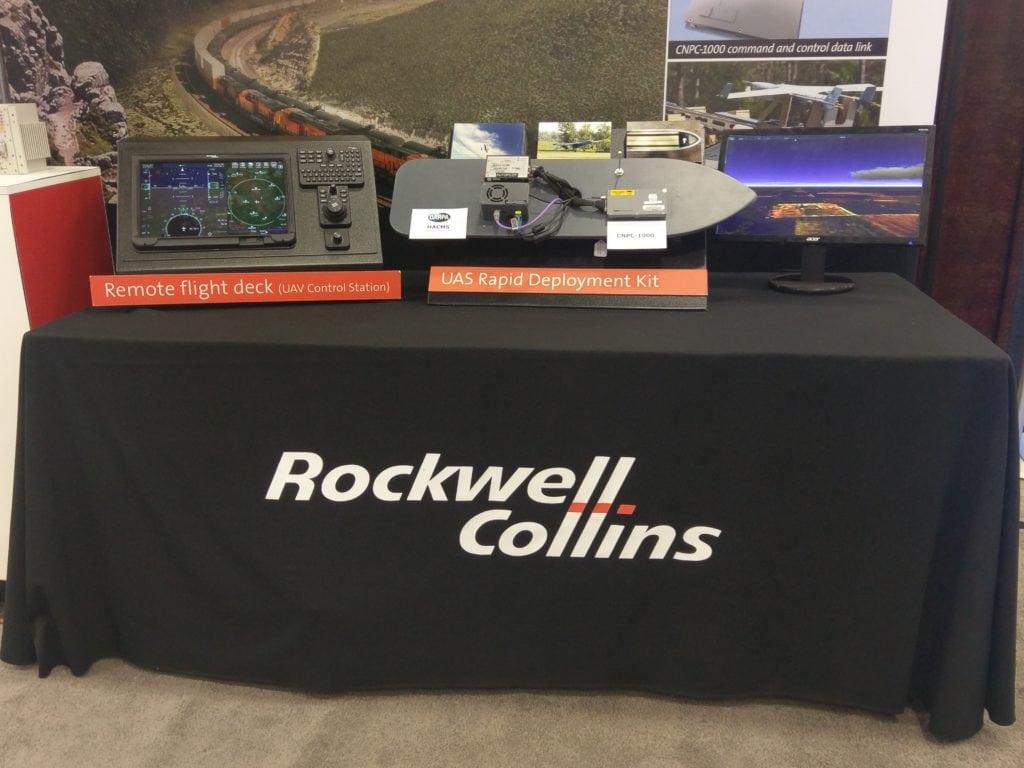
Rockwell Collins exhibits its UAS ground control station and other technologies at AUVSI Xponential 2017.
Rockwell Collins avionics have been supporting U.S. military unmanned aircraft systems (UAS) for years. The company supports the Army’s RQ-7B Shadow and the Navy’s RQ-21 Blackjack, to name a couple — not to mention international militaries. But as the commercial drone market grows, Rockwell Collins is not hesitating to be at the forefront.
In support of BNSF Railway’s beyond-line-of-sight (BLOS) efforts, Rockwell Collins’ CNPC-1000 data link recently helped complete a round of BLOS test flights without visual observers. The company said the tests were the “first true [BLOS] commercial UAS flights in the continental U.S.”
Kevin McElroy, who works in drone business development for Rockwell Collins, explained to Avionics that the Advanced Technology Center helped develop the CNPC-1000. It then was integrated with the company’s Athena integrated navigation product. Once in the aircraft, it could talk to another system on the ground, which is integrated with Rockwell Collins’ certified flight management system and display, Pro Line Fusion.
“This is the same thing that you would find in a business jet. It has all the certification requirements for that controlled airspace access,” McElroy said. “So this is forward-looking to when that type of airspace gets opened up. There’s actually a large UAS manufacturer, that is very forward leaning, that has already purchased this. We’re currently integrating it into their ground station for that airspace access proposition.”
To meet BNSF Railway’s needs, Rockwell Collins took its CNPC-1000 waveform and integrated it into the frequency ranges managed by the railway. With products in the aircraft, in towers along the rail and in the ground control station, the tool is able to perform its command and control function over hundreds of miles. McElroy said the UAS has been able to travel more than 200 nm in a single flight. The plan is to extend the range to facilitate the type of long linear infrastructure inspection that the railway needs.
Why hasn’t Rockwell Collins developed something brand new for this brand new market? Brian Wolford, senior software engineer at the Advanced Technology Center, told Avionics that there’s no need to fix something that isn’t broken.
“We’re taking advantage of a hundred years of knowledge of human factors that we can use that toward UAS,” Wolford said. “All the things that we’ve learned over all this time of manned aviation — it doesn’t make sense to just throw it out. It make sense to take it and use it — use the certification, use the safety that manned aviation has built over the years and keep adding to it for UAS.”
McElroy pointed out that UAS is developing in a similar fashion to manned aviation. It starts out at low altitudes with relatively small aircraft, and the first aspects of the technology get a big push in development from the military, which uses them for targeting. After that, the commercial market starts to take notice, and uses the aircraft for applications, like spraying crops. Then, it’s up to some influential civil entity to push the boundaries. For manned aviation, McElroy credits the U.S. Postal Service for boundary pushing. For UAS, it’s BNSF Railway. And pushing boundaries in the UAS space is set to be simpler than it was for manned aviation because the industry does not have to start from scratch — airliners, jets and helicopters have been there before.
“The problem with manned aviation when it was first coming about is that there was not a lot of regulation to say, ‘What are the rules? How do we keep ourselves safe? How do we keep ourselves separated?” McElroy said. “With unmanned aviation, we have a very robust set of rules that maintains the safest airspace in the world. How do we change those rules, which were all written with the assumption that the pilot of the aircraft would be co-located with the aircraft, in order to maintain that same level of safety? That’s the problem, and it is actually being solved.”
The industry will have to keep waiting for the problem to be solved, entirely. As Rockwell Collins’ solution for BNSF Railway is its first jump into the commercial UAS market, the company still has to wait for the skies to fully open up. The solutions it is developing are made for more sophisticated operations, McElroy said, like BLOS and flying in civilian airspace. Those days will come, and Rockwell Collins will be ready.
“We’re not sitting there, you know, waving our hands at the FAA. They’re doing a very good job; they’re constantly accelerating their efforts,” McElroy said. “We’re looking forward to them moving out of the low altitude into the high altitude controlled airspace. That’s where we think we’re going to have a lot of fun helping people fly.”